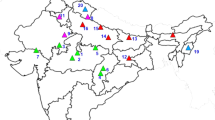Abstract
The aim of the research is to determine the parameters of adaptability of zoned pea varieties. The research was carried out at the FSBSI “Agricultural Research Center “Donskoy”, located in the southern zone of the Rostov region. The objects of research are 17 varieties of seed peas included in the State Register of Selection Achievements approved for use in the North Caucasus region of the Russian Federation. The yield of seeds of pea varieties averaged 2.56 t/ha over the years of research. The yield of the standard variety “Aksai Usatiy” 5 was on average 2.49 t/ha. A significant (HCP05 = 0.21 t/ha) excess was observed in the varieties “Boldor” (3.00 t/ha), “Biathlon” (2.84 t/ha), “Cadet” (2.73 t/ha), and “Ataman” (2.71 t/ha). The reaction rates of each of the studied varieties to the formed weather and climatic conditions were different. The maximum seed yield for most varieties was obtained in 2021, for the “Laurel” variety, in 2022. The minimum yield for some varieties was formed in 2019, and for “Ataman”, “Cadet”, and “Gothic” varieties in 2020. Varieties with high seed yield and high level of homeostaticity, such as “Alliance” (2.68 t/ha; Hom = 33.5), “Cadet” (2.73 t/ha; Hom = 21.0), “Gothic” (2.66 t/ha; Hom = 65.4) are recommended for obtaining stable yields in limiting conditions. Varieties with high seed yield, but low level of homeostatic, such as “Aksai Usatiy” 7 (2.59 t/ha; Hom = 6.0), “Ataman” (2.71 t/ha; Hom = 9.4), “Dawn” (2.67 t/ha; Hom = 4.9), “Biathlon” (2.66 t/ha; Hom = 4.1), “Boldor” (3.00 t/ha; Hom = 4.7) are recommended for conditions with a high level of agricultural background.
Access this chapter
Tax calculation will be finalised at checkout
Purchases are for personal use only
Similar content being viewed by others
References
Mazur V, Didur I (2020) Legumes are a strategic factor in regulating protein balance and soil fertility. Integration of traditional and innovation processes of development of modern science (Collective monograph) Riga, 2020. https://doi.org/10.30525/978-9934-26-021-6-32
Georgieva N, Kosev V (2020). Model of forage pea (Pisum sativum L.) cultivar in conditions of organic production. Bul J Agric Sci 26(1):91–95
Muoni T, Barnes AP, Öborn I et al (2019) Farmer perceptions of legumes and their functions in smallholder farming systems in east Africa. Int J Agric Sustain 17(3):205–218. https://doi.org/10.1080/14735903.2019.1609166
Tsenov N, Atanasova D, Nankova M et al (2014) Approaches for grading breeding evaluation of winter wheat varieties for grain yield. Sci Rep AU 3:21–35
Kalapchieva S (2013) Model for breeding of high productive garden pea varietie. Rastenievadni Nauki 50:73–76
Arata L, Fabrizi E, Sckokai P (2020) A worldwide analysis of trend in crop yields and yield variability: evidence from FAO data. Econ Model 90:190–208
Tan M, Koc A, Gul ZD (2012) Morphological characteristics and seed yield of east anatolian local forage pea (Pisum sativum ssp. arvense L.) ecotype. Turk J Field Crops 17(1):24–30
Onar AN, Erdogan BY, Ayan I, Acar Z (2014) Homoarginine, b-ODAP, and asparagine contents of grass pea landraces cultivated in Turkey. Food Chem 143:277–281
Mohammed A, Asefie S, Dagnachew W, and Seyum N (2016) Participatory evaluations of field pea (Pisum sativum L.) varieties in Wollo, Ethiopia. Excellent Word J Agric Sci 1(2):1–6
Vozhehova R, Kokovikhin S, Lykhovyd P et al (2020) Statistical yielding models of some irrigated vegetable crops in dependence on water use and heat supply. J Water Land Dev 45:190–197
Din M, Khan F, Karim A et al (2019) of different varieties of pea under agro-climatic conditions of Gilgit-Baltistan. Adv Food Technol Nutr Sci Open J 5(2):50–53. https://doi.org/10.17140/AFTNSOJ-5-156
Kosev V, Mikić A (2012) Assessing relationships between seed yield components in field pea (Pisum sativum L.) cultivars by correlation and path analysis. Span J Agric Res 10:1075–1080
Datta S, Das K (2018) Varietal performance of garden pea (Pisum sativum var. hortense) under terai zone of West Bengal. J Appl Nat Sci 10(3):1032–1036
Rana C, Sharma A, Sharma KC et al (2021) Stability analysis of garden pea (Pisum sativum L.) genotypes under North Western Himalayas using joint regression analysis and GGE biplots. Genet Resour Crop Evol 68:999–1010
Mogiso M (2017) Adaptation and performance on yield and yield components of field pea (Pisum sativum L.) varieties at Adiyo District, Southwestern Ethiopia. J Biol Agric Healthc 7(1):42–46
Author information
Authors and Affiliations
Corresponding author
Editor information
Editors and Affiliations
Rights and permissions
Copyright information
© 2024 The Author(s), under exclusive license to Springer Nature Switzerland AG
About this paper
Cite this paper
Ashiev, A., Habibullin, K., Skulova, M., Pakhomov, V. (2024). Assessment of Adaptability Parameters of Zoned Pea Varieties. In: Zokirjon ugli, K.S., Muratov, A., Ignateva, S. (eds) Fundamental and Applied Scientific Research in the Development of Agriculture in the Far East (AFE-2022). AFE 2023. Lecture Notes in Networks and Systems, vol 733. Springer, Cham. https://doi.org/10.1007/978-3-031-37978-9_104
Download citation
DOI: https://doi.org/10.1007/978-3-031-37978-9_104
Published:
Publisher Name: Springer, Cham
Print ISBN: 978-3-031-37977-2
Online ISBN: 978-3-031-37978-9
eBook Packages: Intelligent Technologies and RoboticsIntelligent Technologies and Robotics (R0)




